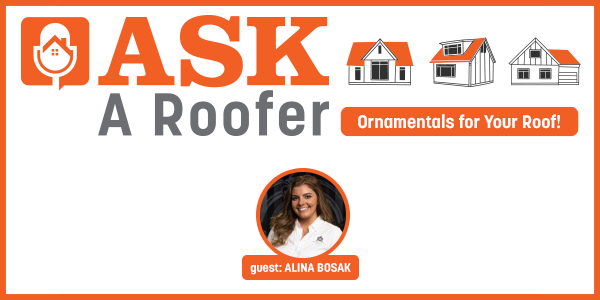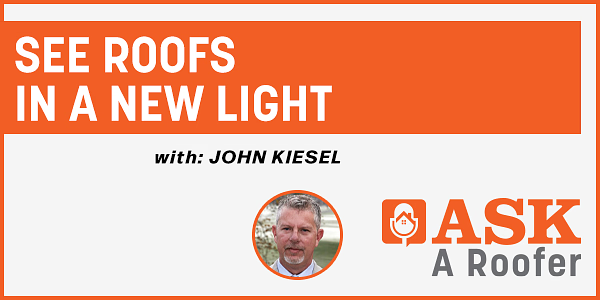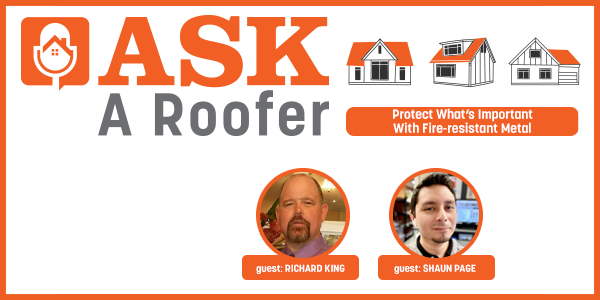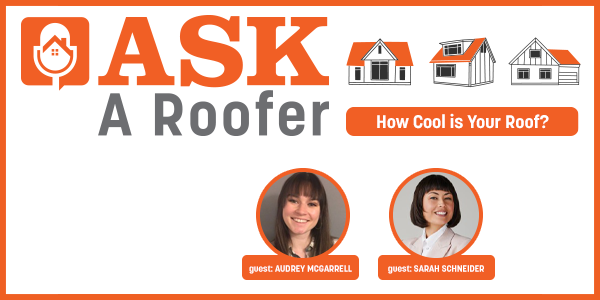Ornamentals for Your Roof! - PODCAST TRANSCRIPTION
August 29, 2023 at 3:00 p.m.Editor's note: The following is the transcript of a live interview with Alina Bosak from Chicago Metal Supply. You can read the interview below or listen to the podcast.
Megan Ellsworth: Hello everyone. My name is Megan Ellsworth.
Lauren White: And I'm Lauren White.
Megan Ellsworth: And this is the Ask a Roofer podcast. We are back again with Chicago Metal Supply, and we're here with Alina. Hi, Alina. How you doing?
Alina Bosak: Hi, Megan. I'm good. Thanks for having me.
Megan Ellsworth: Yeah, we're super excited to have you here. Why don't we just dive right in and have you introduce yourself and Chicago Metal Supply?
Alina Bosak: Okay. Well, as Megan said, my name is Alina Bosak. I'm the president of Chicago Metal Supply. We're a family-owned business. We specialize in architectural sheet metal manufacturing and fabrication that both serves the commercial and the residential trade sector of Chicago, but also all across the U.S., so we actually touch a lot of different states because of our specialization in historical restoration and preservation.
Lauren White: Great.
Megan Ellsworth: Very cool.
Lauren White: All right, so let's get into it and get down to the brass tacks, pun intended. What is a roof ornamental?
Alina Bosak: A roof ornamental, it specifically refers to products like finials or cupolas, weather veins, something extra that's added to a roof for decorative purposes. No one ever needs to have a finial or weather vein on their roof. They do it because they're investing in the artwork of their roof or their building. It doesn't necessarily just have to be on the roof.
Before this podcast, I was actually just really curious, so I looked up the history of sheet metal ornamentals. It's actually something that hit the U.S. in the 1830s in Cincinnati, of course, of all places.
Lauren White: Whoa!
Alina Bosak: It actually started by some stone cornice that crushed two men because it fell on it off of a building, and then a sheet iron worker said, "Oh, my gosh, we got to come up with something lighter and cheaper than stone or wood and something that can bend easily." Obviously, they looked at metal and copper, so then they just started creating cornices and stamping those decorative materials and pieces that they're putting on buildings. Then it just became profitable and hit the Midwest and East Coast and took off from there. It's been ever since something that is an extra aesthetic on a building. I love that in Chicago we have lots of examples of that.
Lauren White: That's so crazy.
Megan Ellsworth: That's cool. I didn't even really realize there was such a big market for those kind of things.
Alina Bosak: Yeah, and after that, they said in the early 1900s, it was crazy. There was so many firms that just specialized in ornamentals and sending out catalogs like the Marshall Fields catalogs that were out there. So, it was pretty big, and then you saw it decline with the Great Depression and war and metal needing to be used for other purposes. I just thought that was a cool, fun fact to go out there.
Lauren White: Yeah, that's very cool.
Megan Ellsworth: Wow.
Alina Bosak: So long answer to what a roof ornamental is.
Lauren White: Yeah, it's great. I have no idea any of that, so that's fun.
Megan Ellsworth: Yeah, so do ornamentals, do they differ for shingle or flat roofs than they do for metal roofs?
Alina Bosak: Really good question there, but the answer is no because you can virtually offer the same ornamentals for any kind of roof, whether it be shingles, slate, cedar shake. The fun part about ornamentals is it's completely up to the designer in what they want to add or the homeowner. As I said in the beginning, you don't need an ornamental piece on your home, so you do it because you want that extra artwork on your facade.
There's really endless possibilities. With that being said, with weather veins on a flat roof, you just probably won't see it just because it won't work because flat roofs have a different design and the function that really only allows for decoration to be seen on the perimeter. So, you'll see a cornice rather than a weather vein, but there's virtually anything that can go on a shingle roof versus a cedar shake or a metal.
Megan Ellsworth: Weather veins, just so I'm clear, those are things that spin, and they have the directions, and it's usually like a chicken.
Alina Bosak: Yeah.
Megan Ellsworth: Okay.
Alina Bosak: Yeah. We have really cool ones here at Chicago Metal. We have wine bottles. We have a golfer if you want. They virtually can create anything. They cease to amaze me with the things that they can put just because someone has a passion for wines, so they can put a wine bottle. [inaudible]
Megan Ellsworth: We know some people like that.
Alina Bosak: Yeah, in Chicago, it's the Windy City, so a lot of people add weather veins as a decorative ornamental, whether it be on top of the chimney cap or a finial. I keep using that example.
Lauren White: Funny.
Megan Ellsworth: That's awesome.
Lauren White: Very cool. At Chicago Metal Supply, what type of ornamentals do you all make? Or do you have a specialty? We were just talking about the weather veins.
Alina Bosak: Actually, we do any kind of ornamental that anybody would want. What we do is what people want and ask for. But our specialty, I would probably say, is restoring ornamentals. So, a lot of people come with us with, we actually had a cool lamp that's on the street, so a street lamp that was old in Chicago, in Old Town. They came, and it was an old copper piece. And we restored it. So, that's really our specialty is we're able to recreate something that once was there and is damaged, or maybe you just have a picture of it and you saw your block 50 years ago and you want to recreate something that was on your building. We have a lot of customers that come in and say that they saw a picture of their building 100 years ago, and they want that cornice back on there.
That's the fun part is we specialize in being able to recreate that stuff, but any kind of finial/cupola that you want, we can make it. Our team is awesome.
Lauren White: Very cool.
Megan Ellsworth: Wow. Wow.
Lauren White: Do you have a favorite one that has come through or been requested?
Megan Ellsworth: Yes.
Alina Bosak: Honestly, because I'm a wine person, the weather vein.
Lauren White: Nice.
Alina Bosak: But I love seeing the skylights that we've recently ... With the rain that's been coming down everywhere, a lot of people now are requesting to have skylights restored or redone, and I love seeing when you have that glass skylight with the copper ridge caps all over it. It was completely made out of copper minus the glass parts, and I love seeing how they make that and then also just how it looks. If you can imagine, you're looking up in your kitchen and you have this skylight, you could see the copper from there, but then you can also see it down the block.
Lauren White: Yeah, that is cool.
Megan Ellsworth: Yeah, I love a skylight. Who doesn't love a skylight?
Lauren White: Especially copper with that nice little pop. So good.
Megan Ellsworth: Yeah!
Alina Bosak: Yeah, and it does pop with the glass.
Megan Ellsworth: That's so nice.
Alina Bosak: [inaudible] my favorite too.
Megan Ellsworth: You've been mentioning all these different terms for different ornamentals. Specifically, what is a conductor head, and what is its purpose?
Alina Bosak: Yeah, good question too because a lot of what we do is a lot of conductor heads just because it is such a simple and easy add. A conductor head is essentially ... It could be functional or non-functional, but either way, it's a collector box. If you've heard of a collector box, a scupper box, a conductor head, a lot of them have the same purpose. You'll typically see a non-functional conductor head below the soffit or a cornice. Whereas a functional will be closer to the through wall opening in order to collect the water.
Now, collector boxes are essentially there to alleviate the water flow and help the downspouts get caught up with the distribution of water away from a building. So, you'll see it either on top or attached to a downspout, and a lot of the times, you'll see a decorative strap around it, or that decorative strap will be on the downspout. It's a really cool way and super easy to get that extra oomph from across the street and see that copper touch on it. A lot of homeowners love adding ornamental conductor heads because it just really looks nice and it could be functional or non-functional.
Megan Ellsworth: Okay, very cool. Thank you for answering that.
Lauren White: We have some information about what ornamentals are. How can a homeowner jazz up the roof with something that's either functional or maybe non-functional, but still beautiful to add to their curb appeal and make them happy when they look at their roof?
Alina Bosak: Yeah, for sure. I love to see a copper bay window. You can have a copper window already put in, or you can add the copper on the outsides of the bay window. We see that a lot in Chicago just because a very popular architectural aspect of our buildings out here. A lot of people like to add ornamental ridge caps, so that will enhance your home's exterior curb appeal, but then also it's available in different products. You can do it in copper. You can do it in zinc. That's just something extra laid across the tops of a lot of shingle or slate roofs.
We see turret caps with ornamental finials too. Then, like I mentioned, the skylights have been something that exploded too because you can see it from your backyard. You can see it from across the street, and then you can also enjoy it while being inside your house.
Lauren White: Definitely.
Alina Bosak: So, lots of different ways that you can do it, and they can both be functional and non-functional.
Megan Ellsworth: Have you found that skylights are becoming more popular in recent years, or have they just always been popular?
Alina Bosak: That's a good question. I would say in Chicago where you don't get a lot of light because the lots are so close together and the buildings are one right after another, you have this short, small alleyway, so then you don't have a lot of natural light from the windows. I would say in Chicago it's always been popular on that top floor to add that just so you can get some sort of natural light. But I would think with homeowners, it's becoming way more popular because we are just seeing that with our sales. People want to add that because they see it in another house or they had it at their last house or they want to add it, and it's a cool way to add that natural light through your roof.
Megan Ellsworth: Yeah, I didn't even really think of skylights as ornamentals until this podcast right now, but they totally are. That's crazy.
Alina Bosak: And you can also think of an ornamental as something that you're adding to something that's also functional. It doesn't necessarily have to be a finial that's completely ornamental, non-functional. It could be something like I had mentioned with the bay windows that you're just adding the extra copper, the zinc, or any kind of material to the outside or to the perimeter of it. It's [inaudible] business for sure.
Megan Ellsworth: Very cool.
Lauren White: So, where can homeowners find your products to use on their own homes if they are in dire need of a skylight now?
Alina Bosak: A skylight's going to be way more unique and full of measurements, but like I mentioned with conductor heads, a lot of people will, even if it's not a copper conductor head or they want it to just be the slate color, they can add a rosette stone on it. That's something that's stamped out, and you can add some floral, copper design on there. A lot of our stamps are actually on our website and organized in the gallery, but also just our products. Because we do everything custom to what someone wants, a lot of it is not ready-made and waiting for you in stock. So, a lot of the times, it's us taking pictures of what we've already done for someone. You'll find a lot of that on our social media page and on our especially Facebook because that's done as it's being pushed out the door, and then we add it and tag where it's going and if, of course, the customer allows.
A lot of it's on the website, but then also in our showroom too with miniature examples. And if you're still ever unsure about anything, a lot of our team takes custom orders over the phone by just having a conversation and discussion about what the customer's looking for. Then we'll send pictures, and they'll come to the showroom, and then we'll draw something up for them. It'll just be a back and forth, which is why that just amazes me every day with their craftsmanship and then how they essentially build a piece from discussions and drawings with the customers. It's really unique, and that's why it's so cool because it's your dream put into a piece.
Lauren White: Yeah, definitely.
Megan Ellsworth: Yeah, that is really cool.
Lauren White: Is copper one of your more used materials or is it evenly spread?
Alina Bosak: You know what? Copper with ornamentals is just because, I want to say, the area. Because if you go and look at Europe, a lot of their ornamentals are actually made out of zinc, whereas we don't have that push yet for zinc in the U.S. There definitely is zinc now being used, but copper is something that was greatly used here probably just because we have the mills in the U.S. to produce it, and they've been around for hundreds of years, as you guys probably know.
Revere Copper, that's been around since after the Revolutionary War, so copper has just always been something that's had over here and just because how it patinas. A lot of people want to keep with the original look. Also, a lot of, I don't know about you guys, but a lot of houses are brick over here in the Midwest, and brick and copper just looks really nice. So, we do a lot of copper here just because a lot of houses are made out of brick here.
Lauren White: Makes sense.
Megan Ellsworth: Yeah, do you find that people are usually ordering weather veins in copper too, or is that zinc or aluminum?
Alina Bosak: Copper.
Megan Ellsworth: Copper.
Alina Bosak: A lot of weather veins, copper, just because a lot of people love the natural patina look that happens, and if copper is the real made copper, it's a lifetime material. You're going to have that patina over time, and then that's its natural reaction to your environment. And it'll help keep it intact for sure.
Megan Ellsworth: Cool.
Lauren White: That makes sense. It is a good look.
Megan Ellsworth: That's cool. Yeah, the Statue of Liberty, right?
Alina Bosak: I love it. It's really shiny in the beginning, and then after a couple months, it'll subside, and it'll be beautiful. And some people like the natural patina early on, so there's actually certain paints that you can put on it to make it patina faster. I personally, I like when it does it naturally, but it's just really cool.
It also tells a story too. When we get some of these finials or cupolas that are on huge churches, you ask, "Oh, my gosh, this side is black when the other side is still green," and they're like, "Oh, yeah, because the factory down the road hits the wind a certain way, and that makes it all black on the one side." It's just cool. So, if you're into that, it tells a story for sure.
Lauren White: That is really cool, yeah.
Megan Ellsworth: I would not have thought of that.
Alina Bosak: Yeah. Oh, yeah, and it's cool when they're like, "Oh, yeah, that factory hasn't been around for 50 years, but it sped up the process of the patina when it was around." I can't tell you how many crosses we have with bullet holes and everything, and the copper's still standing, and there's a hole in it because there was some war going on 100 years ago.
Lauren White: Wow.
Megan Ellsworth: Oh, my God, that's so cool.
Alina Bosak: Yeah, very cool. We actually just restored that, so it's actually on our Facebook if you want to check that out, but I was looking at that. I'm like, "Huh. It's interesting that it went straight through it perfectly and didn't ruin it at all. The hole is still there, and the cross is perfectly intact."
Lauren White: Wow.
Megan Ellsworth: Wow, that's very impressive. Is there anything else homeowners should know about the care, maintenance, and installation of ornamentals?
Alina Bosak: Yeah, a lot of the care and maintenance depends on the metal being used, as we mentioned. In the U.S., we do more copper, and we do some zinc. We do brass. You can make it out of steel. Back then that was really popular. So, you'll see the maintenance and the care depend off of that. We also see different things happen to the metal based on which metal you're using for the ornamental, so keeping an eye out on damage that can be done by the weather or nature, like birds. You'd be surprised what they do to those weather veins and finials, so anything sticking out of a roof that's not supposed to be there.
Just looking at that and then paying attention to sometimes solder can come loose if it wasn't done properly. But well done and real made copper's, like I mentioned, a lifetime material, so it should be on there and stay on there. Then if it's also lapped incorrectly, sometimes that'll allow for water flow, and you don't want that to happen, obviously. So, if you're putting something on the tippy top of your roof, and it's a finial, you want it definitely lapped correctly for sure.
Other than that, those are on there to stay. That's why it's so awesome, and that's why they last so long. And it definitely gives the extra aesthetic.
Megan Ellsworth: Very cool. Very cool.
Lauren White: Just one more. Do you, at Chicago Metal Supply, do you guys install the ornamentals that are ordered through you as well, or does somebody else do that?
Alina Bosak: We don't. We don't. Yeah, we're strictly from the beginning stages with designing because our team is so awesome at doing that and then creating it, and then we will ship it to the job site. And that's it. A lot of the times we, because it's custom and because all we do is custom orders on ornamentals, we're going to help them and make sure that they have the tools that are needed to install it correctly because a lot of our workers, believe it or not, have been on the install side. So, they're really good at being like, "Hey, watch out for this because if you don't put this in correctly you'll have water flow here," or, "Make sure it's secured correctly."
So, we don't install, but we have a team of experts for sure that can help with that.
Megan Ellsworth: Yeah, that's interesting too that ... I'm assuming. Do any of the homeowners that buy these ornamentals, do they install them themselves or is it usually they're hiring a contractor, doing it during a job?
Alina Bosak: Yeah, we usually don't recommend them because a lot of them will come in off the street and say, "Oh, I just saw that this fell off my building. I don't even know what it is," and it's a huge cornice. It's literally 20 feet long, and they bring it in pieces to us. And we're like, "Oh, okay." So, that's why also I give so much credit to our team because of their patience. We love the homework. A lot of the time, they don't even know what they're even asking.
So, they come in and give us pictures or give us a part of the piece, and we'll help them design it and go through that whole process with them. Our customers are essentially a bigger part, are the actual installers, so we'll always recommend someone that we know does a lot of historic restoration installation or that deals a lot with copper. We for sure guide them to who they need to talk to once we do get that design going and all that.
Lauren White: Makes sense.
Megan Ellsworth: Very cool.
Lauren White: It seems safer too.
Megan Ellsworth: Yeah, oh, way safer.
Alina Bosak: You definitely don't want to be installing a finial yourself.
Lauren White: Even a weather vein. I wouldn't want to-
Megan Ellsworth: Or a weather vein.
Lauren White: ... put a weather vein on my house.
Alina Bosak: Okay, if someone's putting it on a shed outside in their backyard, we'll be like, "Okay, but it might fall off in a couple minutes if you don't do it properly."
Megan Ellsworth: Yeah, especially if you have a steep slope roof. Everyone out there, don't get up there. Leave it to the professionals.
Lauren White: Exactly.
Megan Ellsworth: Well, Alina, this has been so informational. Thank you so much for joining us and chatting and sharing your wisdom on ornamentals with us.
Alina Bosak: Absolutely. No, thank you for having me.
Megan Ellsworth: Yeah. Well, hopefully, we'll chat again soon about more ornamentals that you guys are doing and creating, and more custom ones. I hope to hear about the next wine bottle weather vein.
Alina Bosak: Yes, or horse if you're into horses.
Megan Ellsworth: Yes.
Lauren White: Awesome.
Megan Ellsworth: Thank you so much. Lauren, this has been great.
Lauren White: Yes, it has been. Thank you so much, Alina.
Alina Bosak: Thank you.
Megan Ellsworth: Awesome. Well, to everyone out there listening, this has been the Ask a Roofer podcast. You can go find Chicago Metal Supply on rooferscoffeeshop.com and askaroofer.com. Go check out their directory, look at all the custom weather veins they've done, check out their Facebook and all their social media channels so you can see all the cool things that they do, and we will be seeing you next time on the Ask a Roofer podcast.














Comments
Leave a Reply
Have an account? Login to leave a comment!
Sign In